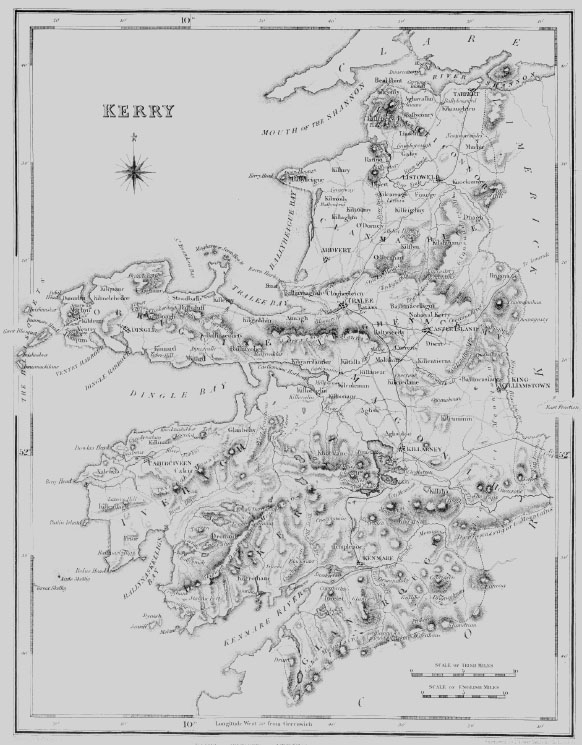| Accompanying Lewis map for Kerry 
|
| BALLYBUNNIAN |
| BALLYBUNNIAN, or BALLYBUNYAN, a village, in the parish of KILLEHENY, barony of IRAGHTICONNOR, county of KERRY, and province of MUNSTER, 8 miles (W. N. W.) from Listowel : the population is returned with the parish. This village, which is situated on a small bay, to which it gives name, in the mouth of the Shannon, has recently become a place of resort for sea-bathing, and is also much frequented on account of the highly interesting and romantic caverns with which its cliffs are indented. The bay is about 500 paces in breadth, and from it to Kilconly Point stretches a fine range of cliffs, presenting a line of coast of the most picturesque character: on the summit of one of the loftiest are vestiges of the old castle of Ballybunnian, with subterranean passages. The cliffs in many places are pierced with extensive caverns and rocky inlets of singular form and variety; those immediately contiguous to the bay, extend in numerous intricate passages, through which a boat may pass for a considerable distance parallel with the coast, without entering the open sea. Beyond these are others of greater depth and height, in one of which pyrites of copper abound; one of the insulated rocks is perforated with an arch, through which is a passage for boats; another extreme point is penetrated by a still loftier arch, and near it is a vast pillar of rock, rising out of the sea from a narrow base, and called the "Devil's Castle," or the "Eagle's Nest." One of the caverns is about 60 feet high in the interior; and there are several beautiful waterfalls from the summit of the cliffs, on one of which are the remains of Doon castle. These caverns and the geological formation of the coast were the subject of a treatise by W. Ainsworth, Esq., of Dublin, in 1834. Some of the mineral substances of part of the cliffs ignited spontaneously in 1753, and burnt for a considerable time, leaving curious traces of the action of the fire. Ballybunnian House, the property of the Gun family, is occasionally fitted up as an hotel; and there are several lodging-houses for the accommodation of visitors during the bathing season. A very profitable salmon fishery, the property of Christopher Julian, Esq., is carried on: the fish is of very fine quality, and great quantities are cured and sent to London in kits weighing about 40lb. each. Vessels of 50 tons' burden may enter the river at high water and sail up nearly a mile from the beach: and lighters pass up the Cashen a distance of eight miles, with the tide, with sand andsea-weed for manure. -See KILLEHENNY.v |
| KILLEHENY |
| KILLEHENY, or KILLAHINNY, a parish, in the barony of IRAGHTICONNOR, county of KERRY, and province of MUNSTER, 11 miles (S. W. by W.) from Tarbert, on the south. eastern shore of the estuary of the Shannon ; containing 2316 inhabitants. It comprises 7316 statute acres, as applotted under the tithe act, about one-third of which is arable land of good quality ; the remainder is coarse mountain pasture, with a great quantity of bog. Agriculture is improving ; sea-weed and sea-sand are used as manures, and good limestone is abundant. Fine salmon and trout are taken in the river Cashen. There is a telegraph on Knockanore mountain. Spraymount is the residence of Capt. W. Raymond, and the other seats are those of Capt. Hewson, and C. Julian, Esq. In the grounds of the latter some skeletons in stone graves were discovered in 1829. It is a vicarage, in the diocese of Ardfert and Aghadoe, forming part of the union of Aghavallin ; the rectory is impropriate in A. Stoughton, Esq. The tithes amount to £124. 12. 3., of which £83. 1. 4. is payable to the impropriator, and the re-mainder to the vicar. In the R. C. divisions it forms part of the union or district of Lisseltin, and has a chapel at Ballybunnian. About 50 children are educated in a private school. Here are the celebrated caverns of Ballybunnian, which are described under the head of that place. |
|